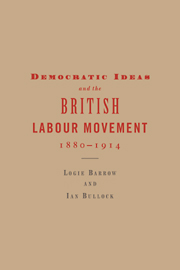2 - Democracy and socialism in the 1890s
Published online by Cambridge University Press: 09 November 2009
Summary
During the 1880s the SDF and the Socialist League disagreed about how the strong democratic values they shared should be put into practice either within the existing socialist organisations or in the socialist society of the future. They also discussed how far it was proper for socialists to participate in the existing electoral system. But neither had any doubt that the system was so far from democratic as to require wholesale replacement, not partial reform.
It was in the 1890s that an alternative version of socialist democracy emerged to challenge this stance. For the Fabians explicitly, and for Keir Hardie and the leadership of the Independent Labour Party (ILP) less stridently, the system needed some reforming in a democratic direction but was generally satisfactory. This judgement applied both in the here-and-now and also for the forseeable and, it was hoped, socialist future.
Fabian democracy and its Social-Democratic critics
The Fabian Society appeared during the years that saw the formation of the SDF and the secession from it of the Socialist League. By the mid-1890s, this self-consciously middle-class body had evolved its own distinctive version of socialism. A central feature was a conception of democracy at variance in spirit and in almost all details with that of the SDF which it sneered at as ‘primitive’.
The evolution of Fabian democracy
This distinctive Fabian view did not crystallise at once. In the mid-80's the Society had experienced a parallel with the Socialist League SDF split.
- Type
- Chapter
- Information
- Publisher: Cambridge University PressPrint publication year: 1996



